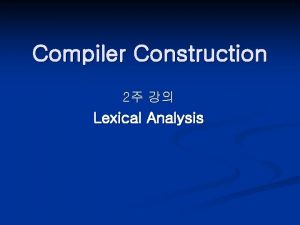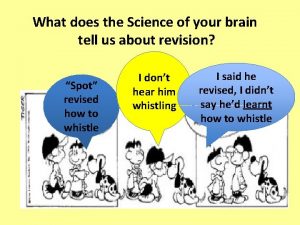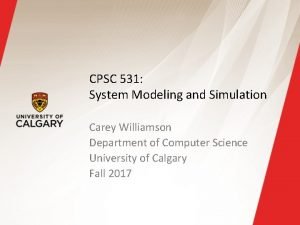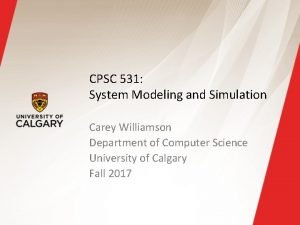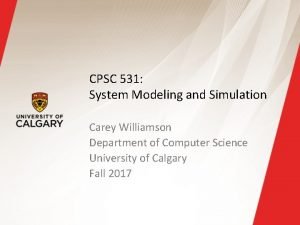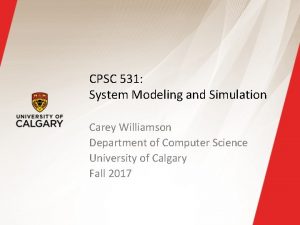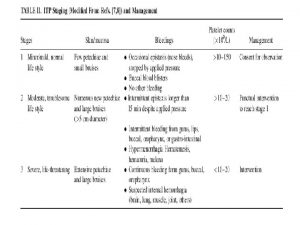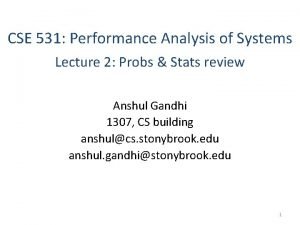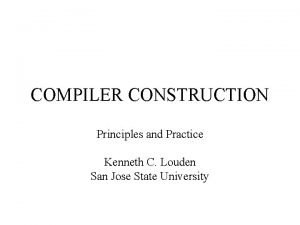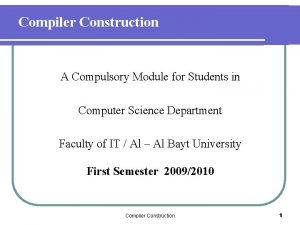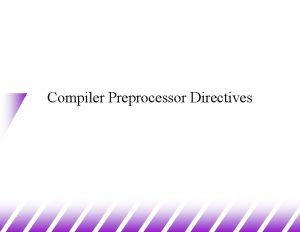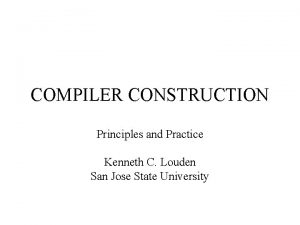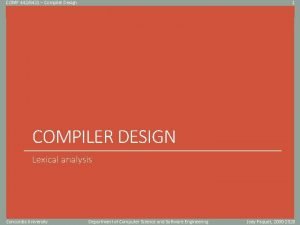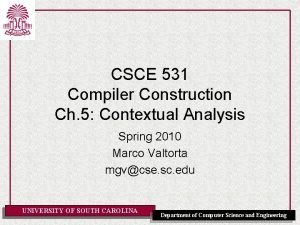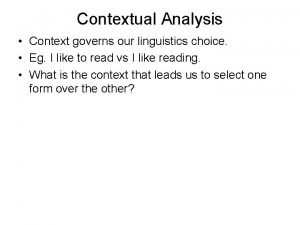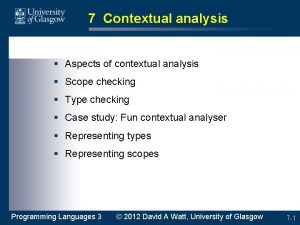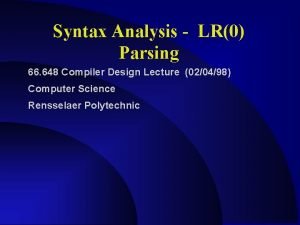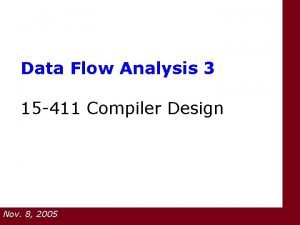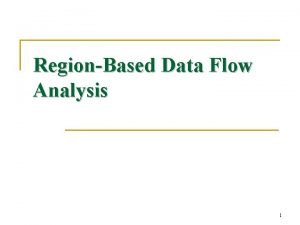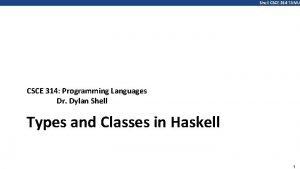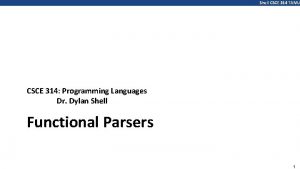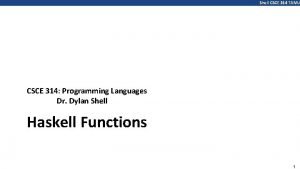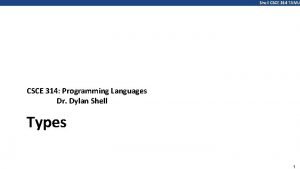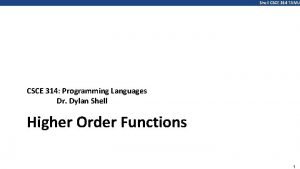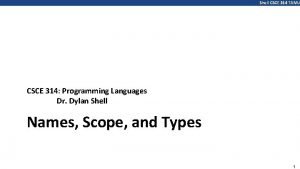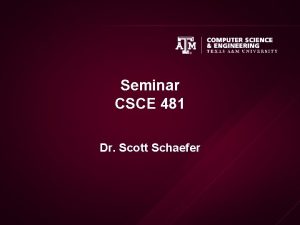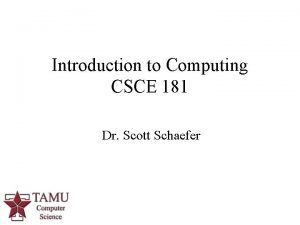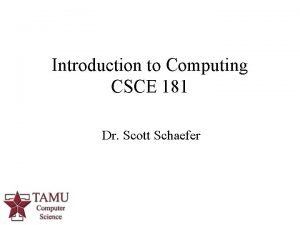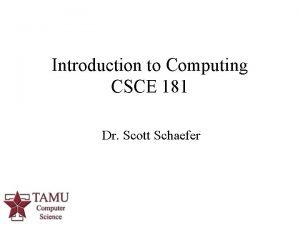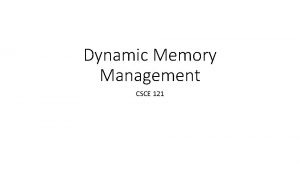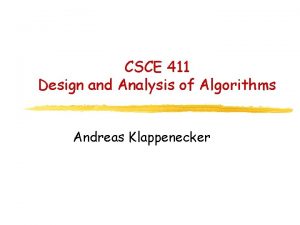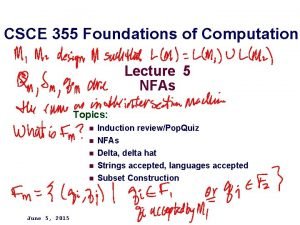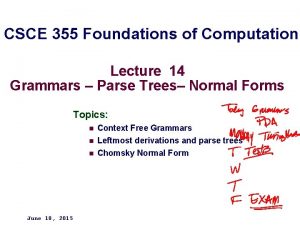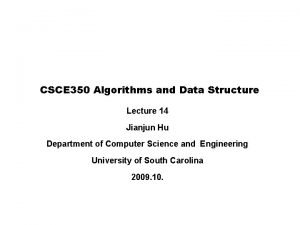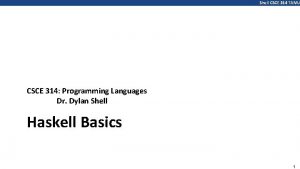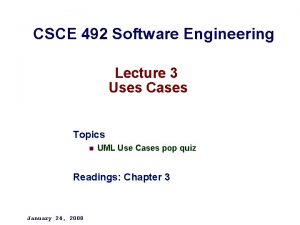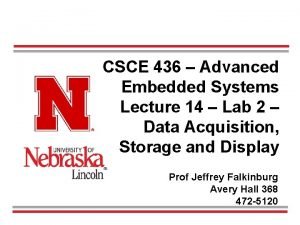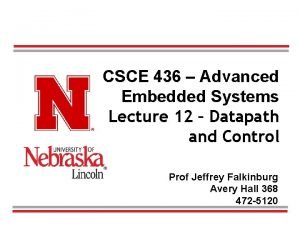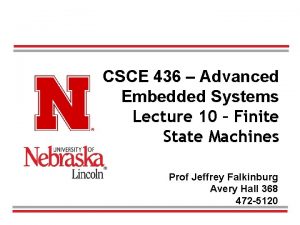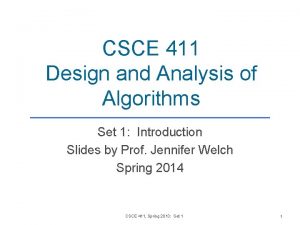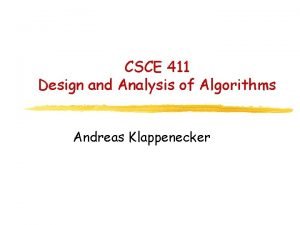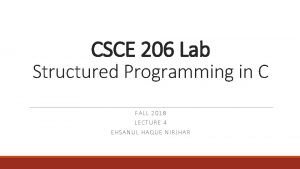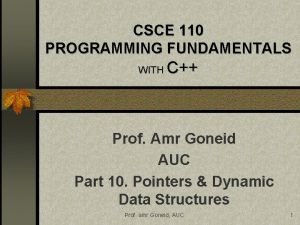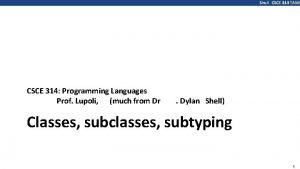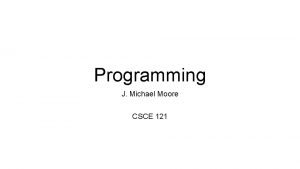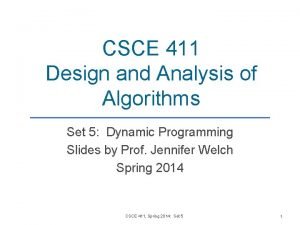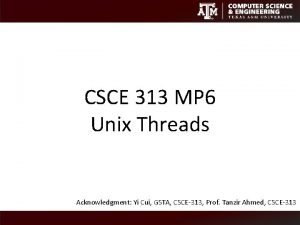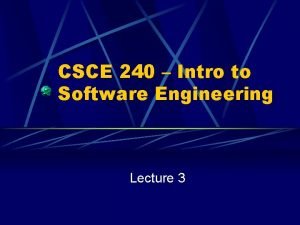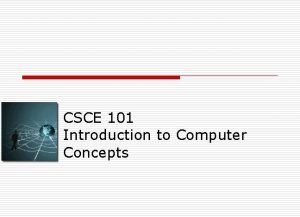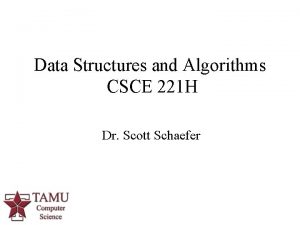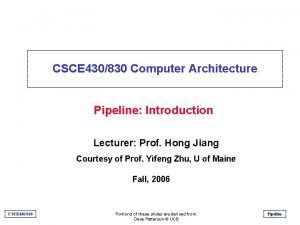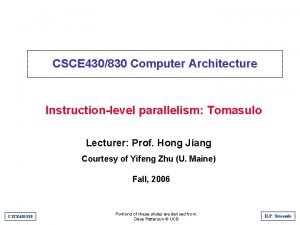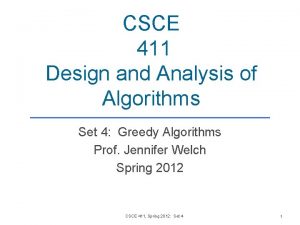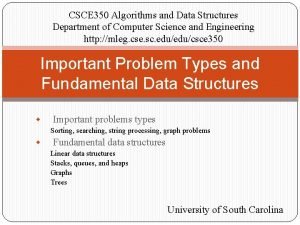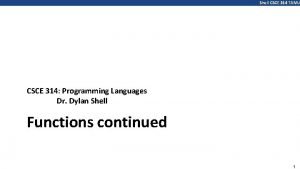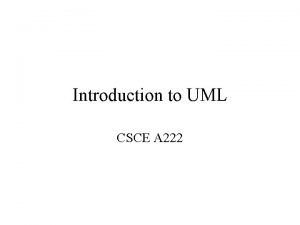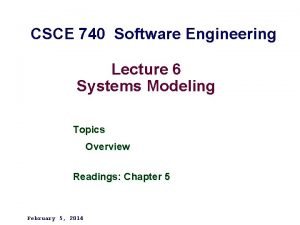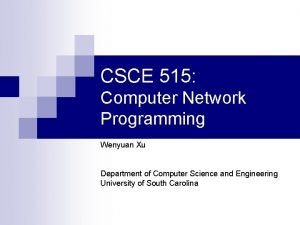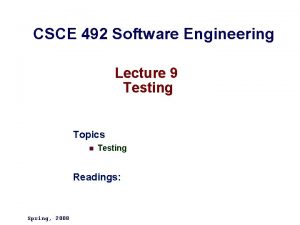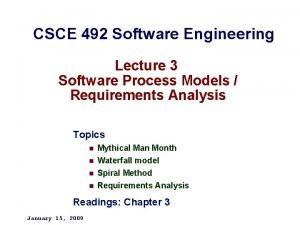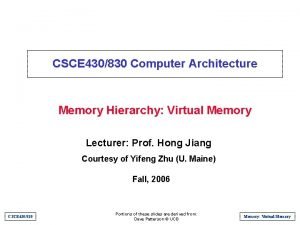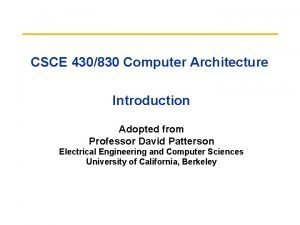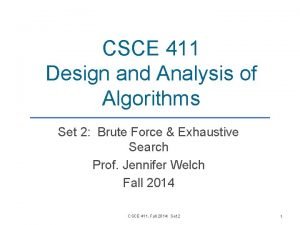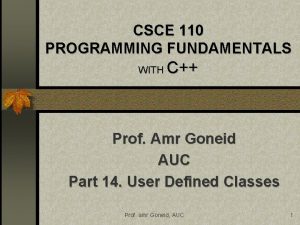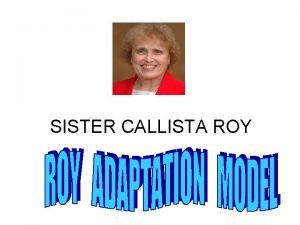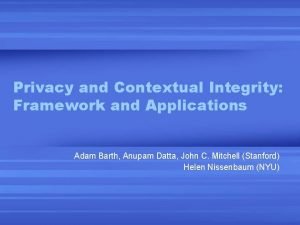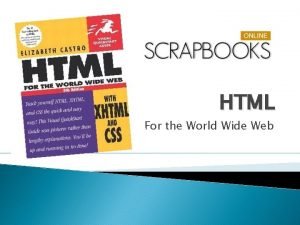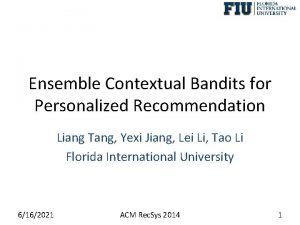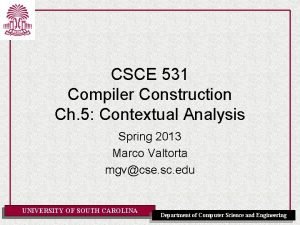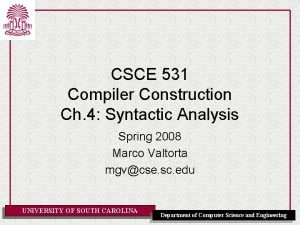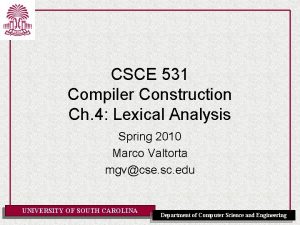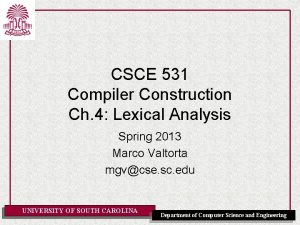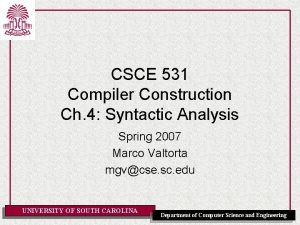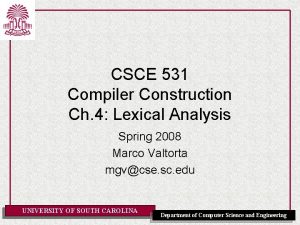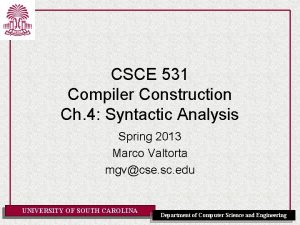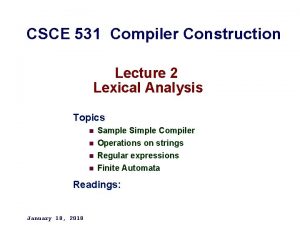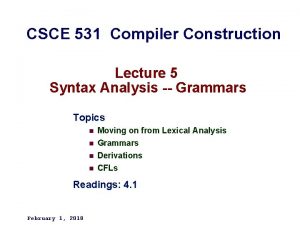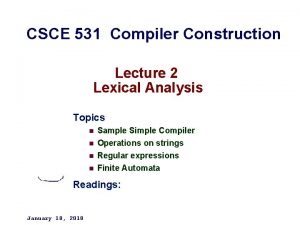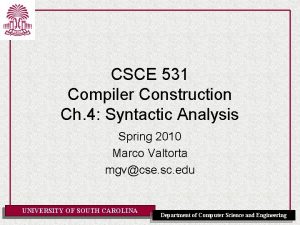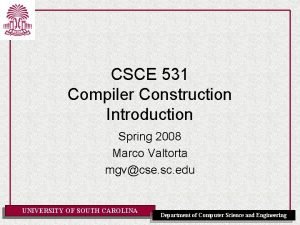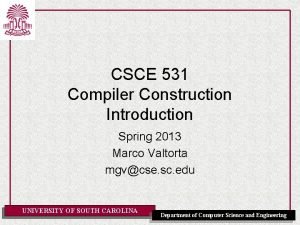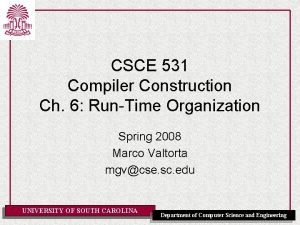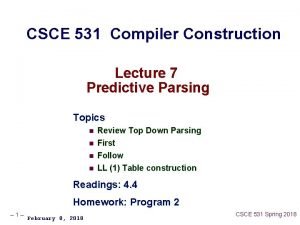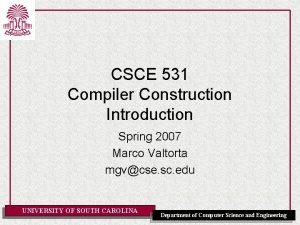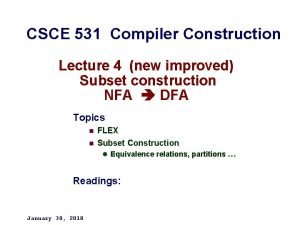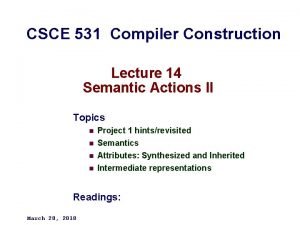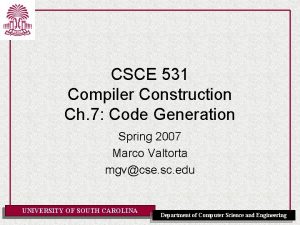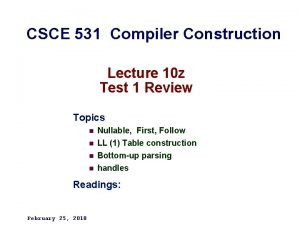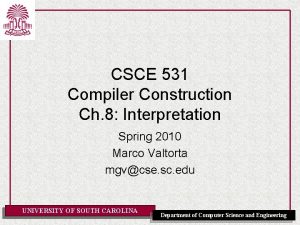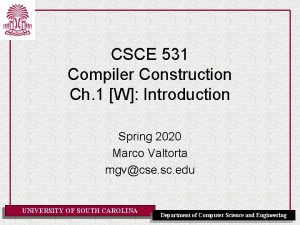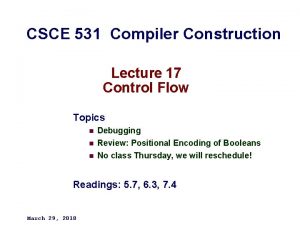CSCE 531 Compiler Construction Ch 5 Contextual Analysis

![Acknowledgment • The slides are based on the required textbooks: [M] and [R] and Acknowledgment • The slides are based on the required textbooks: [M] and [R] and](https://slidetodoc.com/presentation_image_h2/3e8a26ed22bdd5bc47ca2ba9cb583976/image-2.jpg)










![The Attribute Grammar • Syntax rule: <expr> <var>[1] + <var>[2] Semantic rules: <expr>. actual_type The Attribute Grammar • Syntax rule: <expr> <var>[1] + <var>[2] Semantic rules: <expr>. actual_type](https://slidetodoc.com/presentation_image_h2/3e8a26ed22bdd5bc47ca2ba9cb583976/image-13.jpg)
![Attribute Grammars <expr>. expected_type inherited from parent <var>[1]. actual_type lookup (A) <var>[2]. actual_type lookup Attribute Grammars <expr>. expected_type inherited from parent <var>[1]. actual_type lookup (A) <var>[2]. actual_type lookup](https://slidetodoc.com/presentation_image_h2/3e8a26ed22bdd5bc47ca2ba9cb583976/image-14.jpg)



![Attribute Grammar: Example • [Sebesta, 2008] UNIVERSITY OF SOUTH CAROLINA Department of Computer Science Attribute Grammar: Example • [Sebesta, 2008] UNIVERSITY OF SOUTH CAROLINA Department of Computer Science](https://slidetodoc.com/presentation_image_h2/3e8a26ed22bdd5bc47ca2ba9cb583976/image-18.jpg)
![Attribute Flow: Example • [Sebesta, 2008] UNIVERSITY OF SOUTH CAROLINA Department of Computer Science Attribute Flow: Example • [Sebesta, 2008] UNIVERSITY OF SOUTH CAROLINA Department of Computer Science](https://slidetodoc.com/presentation_image_h2/3e8a26ed22bdd5bc47ca2ba9cb583976/image-19.jpg)






















































































- Slides: 105

CSCE 531 Compiler Construction Ch. 5: Contextual Analysis Spring 2020 Marco Valtorta mgv@cse. sc. edu UNIVERSITY OF SOUTH CAROLINA Department of Computer Science and Engineering
![Acknowledgment The slides are based on the required textbooks M and R and Acknowledgment • The slides are based on the required textbooks: [M] and [R] and](https://slidetodoc.com/presentation_image_h2/3e8a26ed22bdd5bc47ca2ba9cb583976/image-2.jpg)
Acknowledgment • The slides are based on the required textbooks: [M] and [R] and other sources • [W] and slides from Bent Thomsen’s course at the University of Aalborg in Denmark, based on [W] • [M 10]: the online version of the edition of Torben Mogensen’s online textbook, Basics of Compiler Design • The three main other compiler textbooks I considered are: – Aho, Alfred V. , Monica S. Lam, Ravi Sethi, and Jeffrey D. Ullman. Compilers: Principles, Techniques, & Tools, 2 nd ed. Addison-Welsey, 2007. (The “dragon book”) – Appel, Andrew W. Modern Compiler Implementation in Java, 2 nd ed. Cambridge, 2002. (Editions in ML and C also available; the “tiger books”) – Grune, Dick, Henri E. Bal, Ceriel J. H. Jacobs, and Koen G. Langendoen. Modern Compiler Design. Wiley, 2000; second edition 2012 [G] UNIVERSITY OF SOUTH CAROLINA Department of Computer Science and Engineering

Contextual Analysis Phase • Purposes: – Finish syntax analysis by deriving contextsensitive information – Associate semantic routines with individual productions of the context free grammar or subtrees of the AST – Start to interpret meaning of program based on its syntactic structure – Prepare for the final stage of compilation: Code generation UNIVERSITY OF SOUTH CAROLINA Department of Computer Science and Engineering

Programming Language specification – A Language specification has (at least) three parts: • Syntax of the language: usually formal: EBNF • Contextual constraints: – scope rules (often written in English, but can be formal) – type rules (formal or informal) • Semantics: – defined by the implementation – informal descriptions in English – formal using operational, denotational, or axiomatic semantics UNIVERSITY OF SOUTH CAROLINA Department of Computer Science and Engineering

The “Phases” of a Compiler Source Program Syntax Analysis Error Reports Today’s lecture Abstract Syntax Tree Contextual Analysis Error Reports Decorated Abstract Syntax Tree Code Generation Object Code UNIVERSITY OF SOUTH CAROLINA Department of Computer Science and Engineering

Recap: Contextual Constraints Syntax rules alone are not enough to specify the format of well-formed programs. Example 1: let const m~2; in m + x Undefined! Example 2: let const m~2 ; var n: Boolean in begin n : = m<4; n : = n+1 Type error! end UNIVERSITY OF SOUTH CAROLINA Scope Rules Type Rules Department of Computer Science and Engineering

Scope Rules Scope rules regulate visibility of identifiers. They relate every applied occurrence of an identifier to a binding occurrence ? Example 1 Binding occurrence Example 2: let const m~2; let const m~2 var r: Integer in m + x in r : = 10*m Applied occurrence Terminology: Static binding vs. dynamic binding UNIVERSITY OF SOUTH CAROLINA Department of Computer Science and Engineering

Type Rules • In order to "tame" the behaviour of programs we can make more or less restrictive type rules • The validity of these rules is controlled by type checking • Details depend upon the type system – Type systems can be very complicated UNIVERSITY OF SOUTH CAROLINA Department of Computer Science and Engineering

Type Rules Type rules regulate the expected types of arguments and types of returned values for the operations of a language. Examples Type rule of < : E 1 < E 2 is type correct and of type Boolean if E 1 and E 2 are type correct and of type Integer Type rule of while: while E do C is type correct if E of type Boolean and C type correct Terminology: Static typing vs. dynamic typing UNIVERSITY OF SOUTH CAROLINA Department of Computer Science and Engineering

Type Checking • Static type checking – All type errors are detected at compile-time – Triangle is statically typed – Most modern languages have a large emphasis on static type checking • Dynamic type checking – Scripting languages such as Java. Script, Ph. P, Perl and Python do run-time type checking • Mix of Static and Dynamic – object-oriented programming requires some runtime type checking: e. g. Java has a lot of compile-time type checking but it is still necessary for some potential runtime type errors to be detected by the runtime system • Static type checking involves calculating or inferring the types of expressions (by using information about the types of their components) and checking that these types are what they should be (e. g. the condition in an if statement must UNIVERSITY OF SOUTH CAROLINA have type Boolean). Department of Computer Science and Engineering

• Action Routines and Attribute Grammars Automatic tools can construct lexer and parser for a given context-free grammar – E. g. Java. CC and JLex/CUP (and Lex/Yacc) • CFGs cannot describe all of the syntax of programming languages – An ad hoc techniques is to annotate the grammar with executable rules – These rules are known as action routines • Action routines can be formalized Attribute Grammars • Primary value of AGs: – Static semantics specification UNIVERSITY OF SOUTH CAROLINA – Compiler design (static semantics checking) Department of Computer Science and Engineering

Attribute Grammars • Example: expressions of the form id + id – id's can be either int_type or real_type – types of the two id's must be the same – type of the expression must match its expected type • BNF: <expr> <var> + <var> id • Attributes: – actual_type - synthesized for <var> and <expr> – expected_type - inherited for <expr> UNIVERSITY OF SOUTH CAROLINA Department Copyright © 2004 Pearson Addison-Wesley. All rights reserved. of Computer Science and Engineering
![The Attribute Grammar Syntax rule expr var1 var2 Semantic rules expr actualtype The Attribute Grammar • Syntax rule: <expr> <var>[1] + <var>[2] Semantic rules: <expr>. actual_type](https://slidetodoc.com/presentation_image_h2/3e8a26ed22bdd5bc47ca2ba9cb583976/image-13.jpg)
The Attribute Grammar • Syntax rule: <expr> <var>[1] + <var>[2] Semantic rules: <expr>. actual_type <var>[1]. actual_type Predicate: <var>[1]. actual_type == <var>[2]. actual_type <expr>. expected_type == <expr>. actual_type • Syntax rule: <var> id Semantic rule: <var>. actual_type lookup (<var>. string) UNIVERSITY OF SOUTH CAROLINA Department Copyright © 2004 Pearson Addison-Wesley. All rights reserved. of Computer Science and Engineering
![Attribute Grammars expr expectedtype inherited from parent var1 actualtype lookup A var2 actualtype lookup Attribute Grammars <expr>. expected_type inherited from parent <var>[1]. actual_type lookup (A) <var>[2]. actual_type lookup](https://slidetodoc.com/presentation_image_h2/3e8a26ed22bdd5bc47ca2ba9cb583976/image-14.jpg)
Attribute Grammars <expr>. expected_type inherited from parent <var>[1]. actual_type lookup (A) <var>[2]. actual_type lookup (B) <var>[1]. actual_type =? <var>[2]. actual_type <expr>. actual_type <var>[1]. actual_type <expr>. actual_type =? <expr>. expected_type UNIVERSITY OF SOUTH CAROLINA Department Copyright © 2004 Pearson Addison-Wesley. All rights reserved. of Computer Science and Engineering

Attribute Grammars • Def: An attribute grammar is a CFG G = (S, N, T, P) with the following additions: – For each grammar symbol x there is a set A(x) of attribute values – Each rule has a set of functions that define certain attributes of the nonterminals in the rule – Each rule has a (possibly empty) set of predicates to check for attribute consistency UNIVERSITY OF SOUTH CAROLINA Department Copyright © 2004 Pearson Addison-Wesley. All rights reserved. of Computer Science and Engineering

Attribute Grammars • Let X 0 X 1. . . Xn be a rule • Functions of the form S(X 0) = f(A(X 1), . . . , A(Xn)) define synthesized attributes • Functions of the form I(Xj) = f(A(X 0), . . . , A(Xn)), for i <= j <= n, define inherited attributes • Initially, there are intrinsic attributes on the leaves UNIVERSITY OF SOUTH CAROLINA Department Copyright © 2004 Pearson Addison-Wesley. All rights reserved. of Computer Science and Engineering

Attribute Grammars • How are attribute values computed? – If all attributes were inherited, the tree could be decorated in top-down order. – If all attributes were synthesized, the tree could be decorated in bottom-up order. – In many cases, both kinds of attributes are used, and it is some combination of topdown and bottom-up that must be used. – Top-down grammars (LL(k)) generally require inherited flows UNIVERSITY OF SOUTH CAROLINA Department Copyright © 2004 Pearson Addison-Wesley. All rights reserved. of Computer Science and Engineering
![Attribute Grammar Example Sebesta 2008 UNIVERSITY OF SOUTH CAROLINA Department of Computer Science Attribute Grammar: Example • [Sebesta, 2008] UNIVERSITY OF SOUTH CAROLINA Department of Computer Science](https://slidetodoc.com/presentation_image_h2/3e8a26ed22bdd5bc47ca2ba9cb583976/image-18.jpg)
Attribute Grammar: Example • [Sebesta, 2008] UNIVERSITY OF SOUTH CAROLINA Department of Computer Science and Engineering
![Attribute Flow Example Sebesta 2008 UNIVERSITY OF SOUTH CAROLINA Department of Computer Science Attribute Flow: Example • [Sebesta, 2008] UNIVERSITY OF SOUTH CAROLINA Department of Computer Science](https://slidetodoc.com/presentation_image_h2/3e8a26ed22bdd5bc47ca2ba9cb583976/image-19.jpg)
Attribute Flow: Example • [Sebesta, 2008] UNIVERSITY OF SOUTH CAROLINA Department of Computer Science and Engineering

Attributed Parse Tree: Example • To compute all attributes, one may require acyclicity of the attribute dependency graph. Less restrictive conditions are sometimes used [Paaki, J. (1995) “Attribute Grammar Paradigms – A High-Level Methodology in Language Implementation. ” ACM Computing Surveys, Vol 27, No 2. • Example from [Sebesta, 2008] UNIVERSITY OF SOUTH CAROLINA Department of Computer Science and Engineering

• Attribute Grammars and Practice The attribute grammar formalism is important – Succinctly makes many points clear – Sets the stage for actual, ad-hoc practice • The problems with attribute grammars motivate practice – Non-local computation – Need for centralized information (globals) • Advantages – Addresses the shortcomings of the AG paradigm – Efficient, flexible • Disadvantages – Must write the code with little assistance UNIVERSITY OF SOUTH CAROLINA Department of Computer – Programmer deals directly with the details Science and Engineering

The Realist’s Alternative Ad-hoc syntax-directed translation • Associate a snippet of code with each production • At each reduction, the corresponding snippet runs • Allowing arbitrary code provides complete flexibility – Includes ability to do tasteless & bad things To make this work • Need names for attributes of each symbol on lhs & rhs – Typically, one attribute passed through parser + arbitrary code (structures, globals, statics, …) – Yacc/CUP introduces $$, $1, $2, … $n, left to right • Need an evaluation scheme UNIVERSITY OF SOUTH CAROLINA – Fits nicely into LR(1) parsing algorithm Department of Computer Science and Engineering

Contextual Analysis Phase • Purposes: – Finish syntax analysis by deriving contextsensitive information • Scoping • (static) type checking – Start to interpret meaning of program based on its syntactic structure – Prepare for the final stage of compilation: Code generation UNIVERSITY OF SOUTH CAROLINA Department of Computer Science and Engineering

Contextual Analyzer • Which contextual constraints might the compiler add? – Is identifier x declared before it is used? – Which declaration of x does an occurrence of x refer to? – Is x an integer, Boolean, array or a function? – Is an expression type-consistent? – Are any names declared but not used? – Has x been initialized before it is being accessed? – Is an array reference out of bounds? – Does a function bar produce a constant value? – Where can x be stored? (heap, stack, …) UNIVERSITY OF SOUTH CAROLINA Department of Computer Science and Engineering

Why contextual analysis can be hard • Questions and answers involve non-local information • Answers mostly depend on values, not syntax • Answers may involve computations Solution alternatives: • Abstract syntax tree – specify non-local computations by walking the tree • Identification tables (sometimes called symbol tables) – central store for facts + checking code • Language design – simplify language UNIVERSITY OF SOUTH CAROLINA Department of Computer Science and Engineering

To simplify the language design or not? • Syntax vs. types – Bool expressions and Int expressions as syntactic categories – One syntactic category of Expressions with types Bexp Bop : = | | true false Bexp Bop Bexp : = & | or | … Int. Exp : = | Literal Int. Exp Iop : = +|-|*|/|… vs Exp : = | Literal Exp op Exp Op : = & | or | + | - | * | / | … • Psychology of syntax errors vs. type errors – Most C programmers accept syntax errors as their fault, but regard typing errors as annoying constraints imposed on them UNIVERSITY OF SOUTH CAROLINA Department of Computer Science and Engineering

Language Issues Example Pascal: Pascal was explicitly designed to be easy to implement with a single pass compiler: – Every identifier must be declared before its first use. ? var n: integer; procedure inc; begin n: =n+1 end UNIVERSITY OF SOUTH CAROLINA procedure inc; begin Undeclared Variable! n: =n+1 end; var n: integer; Department of Computer Science and Engineering

Language Issues Example Pascal: – Every identifier must be declared before it is used. – How to handle mutual recursion then? procedure ping(x: integer) begin. . . pong(x-1); . . . end; procedure pong(x: integer) begin. . . ping(x); . . . end; UNIVERSITY OF SOUTH CAROLINA Department of Computer Science and Engineering

Language Issues Example Pascal: – Every identifier must be declared before it is used. – How to handle mutual recursion then? forward procedure pong(x: integer) procedure ping(x: integer) begin. . . pong(x-1); . . . end; OK! procedure pong(x: integer) begin. . . ping(x); . . . end; UNIVERSITY OF SOUTH CAROLINA Department of Computer Science and Engineering

Language Issues Example SML: – Every identifier must be declared before it is used. – How to handle mutual recursion then? fun ping(x: int)=. . . pong(x-1). . . fun and pong(x: int)=. . . ping(x). . . ; UNIVERSITY OF SOUTH CAROLINA OK! Department of Computer Science and Engineering

Language Issues Example Java: – identifiers can be used before they are declared. – thus a Java compiler needs at least two passes Class Example { void inc() { n = n + 1; } int n; void use() { n = 0 ; inc(); } } UNIVERSITY OF SOUTH CAROLINA Department of Computer Science and Engineering

Contextual Analysis -> Decorated AST Abstract Syntax Tree Contextual Analysis Error Reports Decorated Abstract Syntax Tree Contextual analysis: • Scope checking: verify that all applied occurrences of identifiers are declared • Type checking: verify that all operations in the program are used according to their type rules. Annotate AST: • Applied identifier occurrences => declaration • Expressions => Type UNIVERSITY OF SOUTH CAROLINA Department of Computer Science and Engineering

Multi Pass Compiler A multi pass compiler makes several passes over the program. The output of a preceding phase is stored in a data structure and used by subsequent phases. Dependency diagram of a typical Multi Pass Compiler: Compiler Driver calls Syntactic Analyzer Contextual Analyzer Code Generator input output Source Text AST UNIVERSITY OF SOUTH CAROLINA Decorated AST Object Code Department of Computer Science and Engineering

Contextual Analysis -> Decorated AST Annotations: Program Let. Command result of identification : type result of type checking Sequential. Command Sequential. Declaration Assign. Command Binary. Expr : int Assign. Command Var. Decl Simple. T Ident n Integer Char. Expr : char VName. Exp Int. Expr : int Simple. T Simple. V : char Ident c Char UNIVERSITY OF SOUTH CAROLINA : int Ident Char. Lit Ident c ‘&’ : int n Ident Op Int. Lit n + 1 Department of Computer Science and Engineering

Recursive Identification • The program is represented by an AST • Possibility: – For every identification: traverse tree and find the right declaration and perform typechecking accordingly • Inefficient solution. . . UNIVERSITY OF SOUTH CAROLINA Department of Computer Science and Engineering

Identification Table • The identification table (also often called symbol table) is a dictionary-style data structure in which we somehow store identifier names and relate each identifier to its corresponding attributes. • Typical operations: – Empty the table – Add an entry (Identifier -> Attribute) – Find an entry for an identifier – (open and close scope) UNIVERSITY OF SOUTH CAROLINA Department of Computer Science and Engineering

Identification Table • The organization of the identification table depends on the programming language. • Different kinds of “block structure” in languages: – Monolithic block structure: e. g. BASIC, COBOL – Flat block structure: e. g. Fortran – Nested block structure => Modern “block-structured” programming languages (e. g. Algol, Pascal, C, C++, Scheme, Java, …) a block = an area of text in the program that corresponds to some kind of boundary for the visibility of identifiers. In Triangle C is a block in let D in C end and proc I (FPS) ~ C block structure = the textual relationship between blocks in a program. UNIVERSITY OF SOUTH CAROLINA Department of Computer Science and Engineering

Different kinds of Block Structure Monolithic UNIVERSITY OF SOUTH CAROLINA Flat Nested Department of Computer Science and Engineering

Monolithic Block Structure Monolithic A language exhibits monolithic block structure if the only block is the entire program. => Every identifier is visible throughout the entire program Very simple scope rules: • No identifier may be declared more than once • For every applied occurrence of an identifier I there must be a corresponding declaration. UNIVERSITY OF SOUTH CAROLINA Department of Computer Science and Engineering

Flat Block Structure Flat A language exhibits flat block structure if the program can be subdivided into several disjoint blocks There are two scope levels: global or local. Typical scope rules: • a globally defined identifier may be redefined locally • several local definitions of a single identifier may occur in different blocks (but not in the same block) • For every applied occurrence of an identifier there must be either a local declaration within the same block or a global declaration. UNIVERSITY OF SOUTH CAROLINA Department of Computer Science and Engineering

Nested Block Structure Nested A language exhibits nested block structure if blocks may be nested one within another (typically with no upper bound on the level of nesting that is allowed). There can be any number of scope levels (depending on the level of nesting of blocks): Typical scope rules: • no identifier may be declared more than once within the same block (at the same level). • for any applied occurrence there must be a corresponding declaration, either within the same block or in a block in which it is nested. UNIVERSITY OF SOUTH CAROLINA Department of Computer Science and Engineering

Identification Table For a typical programming language, i. e. statically scoped language and with nested block structure we can visualize the structure of all scopes within a program as a kind of tree. Global A A 1 A B A 2 A 3 B Lookup path for an applied A 1 A 2 A 3 occurrence in A 3 = “direction” of identifier lookup At any one time (in analyzing the program) only a single path on the tree is accessible. => We don’t necessarily need to keep the whole “scope” tree in memory all the time. UNIVERSITY OF SOUTH CAROLINA Department of Computer Science and Engineering

Identification Table: Example let var a: Integer; var b: Boolean in begin. . . let var b: Integer; var c: Boolean in begin. . . end. . . let var d: Boolean; var e: Integer in begin let const x: 3 in. . . end UNIVERSITY OF SOUTH CAROLINA Level Ident Attr 1 a (1) Level 1 b (2) Ident 1 a 1 b 2 c Level 1 1 2 2 Attr (1) (2) (3) (4) Ident Attr a (1) Level Ident Attr b (2) 1 a (1) d (5) 1 b (2) e (6) 2 d (5) 2 e (6) 3 x (7) Department of Computer Science and Engineering

Identification Table Implementation public class Identification. Table { /** Adds a new entry */ public void enter(String id, Attribute attr) {. . . } /** Retrieve a previously added entry. Returns null when no entry for this identifier is found */ public Attribute retrieve(String id) {. . . } /** Add a new deepest nesting level to the identification table */ public void open. Scope() {. . . } /** Remove the deepest scope level from the table. Deletes all entries associated with it */ public void close. Scope() {. . . }. . . UNIVERSITY OF SOUTH CAROLINA Department of Computer Science and Engineering

Identification Table Implementation • We can use our favorite implementation of a look-up table. – linked list and linear search (easy but slow) – hash table (more efficient) – stack of hash tables It’s essential that an identifier can appear in the table many times, with different levels, and that look-up returns the entry with the highest level. (Linked list makes this easy; hash table - perhaps make the entries linked lists; more complicated possibilities exist. ) UNIVERSITY OF SOUTH CAROLINA Department of Computer Science and Engineering

Attributes public void enter(String id, Attribute attr) {. . . } public Attribute retrieve(String id) {. . . } What are these attributes? (Or in other words: What information do we need to store about identifiers) To understand what information needs to be stored… you first have to understand what the information will be used for! • Checking Scope Rules • Checking Type Rules Q: So… what information is required by each of these two subphases and where does it come from? UNIVERSITY OF SOUTH CAROLINA Department of Computer Science and Engineering

Attributes The ID table needs to provide information needed for • Checking Scope Rules • Checking Type Rules Example 1: let const m~2; Scope Rules in m + x Undefined! Example 2: let const m~2 ; var n: Boolean in begin n : = m<4; n : = n+1 Type error! end UNIVERSITY OF SOUTH CAROLINA Type Rules Department of Computer Science and Engineering

Attributes The ID table needs to provide information needed for • Checking Scope Rules • Checking Type Rules To check scope rules, all we need to know is whether or not a corresponding declaration exists. To check type rules we need to be able to find the type of an applied occurrence. => One possible solution is to enter type information into the identification (ID) table. => Attribute = type information. UNIVERSITY OF SOUTH CAROLINA Department of Computer Science and Engineering

Attributes: Example 1: Mini-Triangle attributes Mini Triangle is very simple: there are only two kinds of declarations single-Declaration : : = const Identifier ~ Expression | var Identifier : Type-denoter. . . and only two types of values: INT or BOOL public class Attribute { public static final byte CONST = 0, VAR = 1; // two kinds of declaration BOOL = 0, INT = 1; // two types byte kind; // either CONST or VAR byte type; // either BOOL or INT } UNIVERSITY OF SOUTH CAROLINA Department of Computer Science and Engineering

Attributes: Example 2: Triangle attributes Triangle is more complex => more kinds of declarations and public types. abstract class Attribute {. . . } public class Const. Attribute extends Attribute {. . . } public class Var. Attribute extends Attribute {. . . } public class Proc. Attribute extends Attribute {. . . } public class Func. Attribute extends Attribute { Formal. List formals; //a list of (identifier, attribute) pairs Type result. Type; } public class Type. Attribute extends Attribute {. . . } public abstract class Type {. . . } public class Bool. Type extends Type {. . . } public class Char. Type extends Type {. . . } public class Int. Type extends Type {. . . } public class Array. Type extends Type { int element. Count; Type element. Type; } public class Record. Type extends Type { Field. List fields; // a list of (identifier, type) pairs } UNIVERSITY OF SOUTH CAROLINA Department of Computer Science and Engineering

Attributes: Pointers to Declaration AST’s Mini Triangle is very simple, but in a more realistic language the attributes can be quite complicated (many different kinds of identifiers and many different types of values) => The implementation of “attributes” becomes much more complex and tedious. Observation: The declarations of identifiers provide the necessary information for attributes. => For some languages, a practical way to represent attributes is simply as pointers to the AST-subtree of the actual declaration of an identifier. UNIVERSITY OF SOUTH CAROLINA Department of Computer Science and Engineering

Attributes as pointers to Declaration ASTs Program Let. Command Sequential. Decl Var. Decl Ident x Let. Command Var. Decl Ident int a bool Var. Decl Ident y int Id table Level Ident 1 x 1 a 2 y Attr • • • Figure 5. 4 (p. 148) in text shows how the table changes during contextual analysis of each of two blocks. enter and retrieve are used. OF SOUTH CAROLINA UNIVERSITY Department of Computer Science and Engineering

The Standard Environment • Most programming languages have a set of predefined functions, operators etc. • We call this the standard environment – top-level environment in ML: http: //www. standardml. org/Basis/toplevel-chapter. html – standard environment in Triangle (p. 401) – standard environment in Mini-Triangle (p. 149) – standard prelude in Haskell: “The Prelude: a standard module imported by default into all Haskell modules. ” See Chapter 9 *”Standard Prelude” at: https: //www. haskell. org/definition/haskell 2010. pdf – java. lang in Java: “Provides classes that are fundamental to the design of the Java programming language” (java. sun. com) – The package Standard in Ada: http: //www. ida. liu. se/edu/ugrad/progkon/Ada/adadoc/LRM 95/rm 95 html/rm 9 x-A-01. html At the start of identification the ID table is not empty but. . . needs to be initialized with representing the standard environment. UNIVERSITY OF entries SOUTH CAROLINA Department of Computer Science and Engineering

The Standard Environment Example: Mini triangle standard environment type Boolean ~. . . ; const false ~. . . ; const true ~. . . ; type Integer ~. . . ; const maxint ~. . . ; func (b: Boolean) : Boolean ~. . . ; func + (i 1: Integer, i 2: Integer) : Integer ~. . . ; func - (i 1: Integer, i 2: Integer) : Integer ~. . . ; func * (i 1: Integer, i 2: Integer) : Integer ~. . . ; func / (i 1: Integer, i 2: Integer) : Integer ~. . . ; func > (i 1: Integer, i 2: Integer) : Boolean ~. . . ; func < (i 1: Integer, i 2: Integer) : Boolean ~. . . ; proc putint(i: Integer) ~. . . ; And for each type T: func = (v 1: T, v 2: T) : Boolean ~. . . ; UNIVERSITY OF SOUTH CAROLINA Department of Computer Science and Engineering

Scope for Standard Environment Should the scope level for the standard environment be the same as the global declarations (level 1) or outside the global declarations (level 0)? – C: level 1 – Mini-Triangle: level 0 • Consequence: 1 let 2 var false : Integer 3 in 4 begin 5 false : = 3; 6 putint ( false ) 7 end is a perfectly correct Mini-Triangle program • Similar with Integer or putint. . . UNIVERSITY OF SOUTH CAROLINA Department of Computer Science and Engineering

Type Checking • RECAP: The contextual analyzer performs two tasks: – identification – (static) type checking • In a statically typed language every expression E either: – Is ill-typed – Or has a static type that can be computed without actually evaluating E • When an expression E has static type T this means that when E is evaluated then the returned value will always have type T • => This makes static type checking possible! UNIVERSITY OF SOUTH CAROLINA Department of Computer Science and Engineering

Type Checking: How Does It Work For most statically typed programming languages, a bottom up algorithm over the AST: • Types of expression AST leaves are known immediately: – literals => obvious – variables => from the ID table – named constants => from the ID table • Types of internal nodes are inferred from the type of the children and the type rule for that kind of. OFexpression UNIVERSITY SOUTH CAROLINA Department of Computer Science and Engineering

Type Checking: How Does It Work Example: Type of a variable (applied occurrence) Var. Decl Simple. VName type Ident type x x UNIVERSITY OF SOUTH CAROLINA Department of Computer Science and Engineering

Type Checking: How Does It Work Example: the type of a binary operation expressions Type rule: If op is an operation of type T 1 x. T 2 ->R then E 1 op E 2 is type correct and of type R if E 1 and E 2 are type correct and have type compatible with T 1 and T 2 respectively Bin. Op bool Int. Expr int 3 Operator intxint->bool < UNIVERSITY OF SOUTH CAROLINA Int. Expr int 4 Department of Computer Science and Engineering

Type checking Commands which contain expressions: Type rule of if. Command: if E do C 1 else C 2 is type correct if E of type Boolean and C 1 and C 2 are type correct deduce that this command is correctly typed If. Command Expression check that this has type Boolean Command typecheck While. Command is similar. UNIVERSITY OF SOUTH CAROLINA Department of Computer Science and Engineering

Type checking Function applications: Function. App Name after identification, we know the type of this function: e. g. f : Integer Boolean deduce that this has type Boolean, and record the type in the AST Expression check that this has type Integer UNIVERSITY OF SOUTH CAROLINA Department of Computer Science and Engineering

Type checking Function definitions: func f(x : Param. Type) : Result. Type ~ Expression Typecheck the function body and calculate its type. Check that the type is Result. Type. Then deduce f : Param. Type Result. Type e. g. f : Integer Boolean UNIVERSITY OF SOUTH CAROLINA Department of Computer Science and Engineering

Type checking Operators in expressions (again): For each operator we know that the operands must have certain types, and that the result has a certain type. This information can be represented by giving the operators function types: + : Integer < : Integer Boolean < deduce that this has type Boolean, and record the type in the AST check that this has type Integer UNIVERSITY OF SOUTH CAROLINA Department of Computer Science and Engineering

Contextual Analysis Identification and type checking are combined into a depth-first traversal Program of the abstract syntax tree. Let. Command Sequential. Declaration Sequential. Command Assign. Command Binary. Expression Var. Dec Simple. T Ident Char. Expr Simple. T Simple. V Ident n Integer c Vname. Expr Int. Expr Simple. V Ident Char. Lit Ident Op Int. Lit Char c ‘&’ n n + 1 UNIVERSITY OF SOUTH CAROLINA Department of Computer Science and Engineering

Contextual Analysis: an Algorithm Identification and Type checking could be done as separate passes over the AST but … In practice the two are often done (interleaved) in a single pass. Every applied occurrence of an identifier must be identified before type checking can proceed. A possible implementation: • One depth-first traversal over the AST to do both identification and type checking. • Results of the analysis recorded in the AST by decorating it. note: For Java the contextual analysis is somewhat more complicated. UNIVERSITY OF SOUTH analysis CAROLINAfor => Contextual Java: several passes. Department of Computer Science and Engineering

Depth-First Traversal Depth-first traversal depends on the structure of the AST - it depends on the number and kind of descendants of each node. Organize it as a collection of functions: analyze. Node. Type analyze. Program(Program P) { … analyze. Command(P. C) … } analyze. If. Command(If. Command C) { … analyze. Expression(C. E) … … analyze. Command(C. C 1)… analyze. Command(C. C 2)… } UNIVERSITY OF SOUTH CAROLINA Department of Computer Science and Engineering

Depth-First Traversal It turns out (later in the course) that code generation also requires a traversal of the AST. So we expect the code generator to be organized similarly: generate. Program(Program P) { … generate. Command(P. C) … } generate. If. Command(If. Command C) { … generate. Expression(C. E) … … generate. Command(C. C 1)… generate. Command(C. C 2)… } UNIVERSITY OF SOUTH CAROLINA Department of Computer Science and Engineering

Implementing Tree Traversal • • “Traditional” OO approach “Functional” approach Visitor approach (Aspect oriented approach) UNIVERSITY OF SOUTH CAROLINA Department of Computer Science and Engineering

Implementing Tree Traversal: Traditional • “Traditional” OO approach would be to add a method to each class, so for each node in the AST we would have a method that knows how to traverse its children. • Scatters code over a large number of classes • Requires recompilation of AST classes each time a method needs changing UNIVERSITY OF SOUTH CAROLINA Department of Computer Science and Engineering

Implementing Tree Traversal: instanceof Another possibility is to use a “functional” approach and implement a case-analysis on the class of an object. Type check(Expr e) { if (e instanceof Int. Lit. Expr) return representation of type int else if (e instanceof Bool. Lit. Expr) return representation of type bool else if (e instanceof Eq. Expr) { Type t = check(((Eq. Expr)e). left); Type u = check(((Eq. Expr)e). right); if (t == representation of type int && u == representation of type int) return representation of type bool. . . UNIVERSITY OF SOUTH CAROLINA Department of Computer Science and Engineering

Implementing Tree Traversal: instanceof This approach leads to a messy nested if, which can’t be converted into a switch because Java has no mechanism for switching on the class of an object. Also this technique is not very object-oriented: instead of explicitly using instanceof, we prefer to arrange for analysis of an object’s class to be done via the built-in mechanisms of overloading and dynamic method dispatch. UNIVERSITY OF SOUTH CAROLINA Department of Computer Science and Engineering

Patterns • Eric Gamma, Richard Helm, Ralph Johnson, and John Vlissides. Design Patterns: Elements of Reusable Object-Oriented Software. Addison-Wesley, 1995. • O-O “design patterns are descriptions of communicating objects and classes that are customized to solve a general design problem in a particular context. ” • ADTs are not considered design patterns. UNIVERSITY OF SOUTH CAROLINA Department of Computer Science and Engineering

How Does a Visitor Work? • The compiler creates a Type. Checking Visitor Object---see p. 155. • The compiler calls the visit operation on the AST with that AST object as an argument. • Each of the nodes implement visit by calling back on the visitor, e. g. , an assignment node calls visit. Assign. Command (p. 159). UNIVERSITY OF SOUTH CAROLINA Department of Computer Science and Engineering

Trade-Offs • The contextual analyzer is all together in a single class, rather than spread out with one method per AST subclass. • If the AST changes, one has to redefine the interface to all visitors, which is costly: in this case, it is better to define the operations in the AST classes themselves. UNIVERSITY OF SOUTH CAROLINA Department of Computer Science and Engineering

Implementing Tree Traversal: Visitor Solution using Visitor: • Visitor is an abstract class that has a different method for each type of object on which it operates • Each operation is a subclass of Visitor and overloads the type-specific methods • Objects that are operated on accept a Visitor and call back their type-specific method passing themselves as operands • Object types are independent of the operations that apply to them • New operations can be added without modifying the object types UNIVERSITY OF SOUTH CAROLINA Department of Computer Science and Engineering

Visitor Solution Node Accept( Node. Visitor v ) • Nodes accept visitors and call appropriate method of the visitor • Visitors implement the operations and have one method for each type of node they visit Variable. Ref. Node Assignment. Node Accept(Node. Visitor v) {v->Visit. Variable. Ref(this)} Accept(Node. Visitor v) {v->Visit. Assignment(this)} Node. Visitor Visit. Assignment( Assignment. Node ) Visit. Variable. Ref( Variable. Ref. Node ) Type. Checking. Visitor Visit. Assignment( Assignment. Node ) Visit. Variable. Ref( Variable. Ref. Node ) UNIVERSITY OF SOUTH CAROLINA Code. Generating. Visitor Visit. Assignment( Assignment. Node ) Visit. Variable. Ref( Variable. Ref. Node ) Department of Computer Science and Engineering

The Visitor Design Pattern Abstracting the common structure of the contextual analyzer and the code generator, we can make use of the visitor design pattern. The Visitor interface specifies a collection of visitor methods which must be implemented by any particular tree traversal. interface Visitor { public Object visit. Program(Program prog, Object arg); public Object visit. Assign. Command(Assign. Command com, Object arg); …} to allow a result to be returned: e. g. the type of an expression, during type checking UNIVERSITY OF SOUTH CAROLINA to allow additional information to be supplied: e. g. during code generation this parameter holds information about the size of the object code Department of Computer Science and Engineering

The Visitor Design Pattern The contextual analyzer and the code generator are implemented as classes that implement the Visitor interface. For example: class Checker implements Visitor { … public Object check. If. Command(If. Command com, Object arg) { … check. Expression(com. E) … … check. Command(com. C 1)… check. Command(com. C 2)… …} … } UNIVERSITY OF SOUTH CAROLINA Department of Computer Science and Engineering

The Visitor Design Pattern There is one further complication. How would we implement Object check. Command(Command com, Object arg) ? com is an instance of one of the classes If. Command, While. Command etc. Within check. Command we should call the appropriate check method, but which one? We would need a messy series of tests using instanceof: if (com instanceof If. Command) check. If. Command(com, arg) else if (com instanceof While. Command) check. While. Command(com, arg) else … UNIVERSITY OF SOUTH CAROLINA Department of Computer Science and Engineering

The Visitor Design Pattern Instead of a long sequence of instanceof tests, we define a visit method in every AST class. It is given a visitor object (for example, an object of class Checker) and simply applies the correct visitor method to itself. class If. Command extends Command { … public Object visit(Visitor v, Object arg) { return v. visit. If. Command(this, arg); } } Instead of calling check. Command(com. C 1, arg) we just call com. C 1. visit(this, arg) (this refers to the current Visitor object). We exploit the fact that com “knows” which class it is an instance o This approach is more in the spirit of OO programming. UNIVERSITY OF SOUTH CAROLINA Department of Computer Science and Engineering

The Visitor Design Pattern The class Checker defines check. If. Command etc. , but there is no check. Command method. To do contextual analysis, we create an object of class Checker: Checker the. Checker = new Checker( ); and apply the top-level checking function to the AST: the. Checker. visit. Program(the. AST, null); within visit. Program we get the call this parameter is only used by the code generator the. AST. C. visit(this, null) because Program contains Command C; UNIVERSITY OF SOUTH CAROLINA refers to the. Checker because visit. Program is defined within Checker Department of Computer Science and Engineering

The Visitor Design Pattern If the Command C within the. AST is an If. Command then the call the. AST. C. visit(the. Checker, null) will execute the. Checker. visit. If. Command(C, null) which is what we want. In summary, the visitor design pattern consists of • classes such as Checker and Code. Generator which implement the interface Visitor • the visit methods within the AST node classes. UNIVERSITY OF SOUTH CAROLINA Department of Computer Science and Engineering

Example: Implementation of Mini-Triangle Contextual Analyzer RECAP: Mini Triangle Abstract Syntax Program : : = Command Program Command : : = V-name : = Expression Assign. Cmd | Identifier ( Expression ) Call. Cmd | if Expression then Command • Expression: Compute its type, make annotation, return type. else Command If. Cmd | while Expression do Command While. Cmd • Commands: Check. Returns void. | let Declaration in Command Let. Cmd • Declaration: Check and enter into id-table, returns void. | Command ; Command Sequential. Cmd V-name : : = Identifier Simple. VName • Identifier: (applied occurrence) make annotation, return … corresponding declaration. UNIVERSITY OF SOUTH CAROLINA Department of Computer Science and Engineering

RECAP: Mini Triangle Abstract Syntax (ctd) Declaration : : = const Identifier ~ Expression Const. Decl | var Identifier : Type. Denoter Var. Decl | Declaration ; Declaration Sequential. Decl Type. Denoter : : = Identifier Simple. Type. Denoter Expression : : = Integer-Literal | V-name | Operator Expression | Expression Op Expression Integer. Expression Vname. Expression Unary. Expression Binary. Expression UNIVERSITY OF SOUTH CAROLINA Department of Computer Science and Engineering

RECAP: AST representation (ctd) Declaration : : = const Identifier ~ Expression | var Identifier : Type. Denoter | Declaration ; Declaration Const. Decl Var. Decl Sequential. Decl AST Declaration Const. Decl Var. Decl UNIVERSITY OF SOUTH CAROLINA Expression Sequential. Decl Department of Computer Science and Engineering

RECAP: AST representation (ctd) Declaration : : = const Identifier ~ Expression | var Identifier : Type. Denoter | Declaration ; Declaration Const. Decl Var. Decl Sequential. Decl public class Const. Decl extends Declaration { public Identifier I; // constant name public Expression E; // constant value. . . } public class Var. Decl extends Declaration {. . . UNIVERSITY OF SOUTH CAROLINA Department of Computer Science and Engineering

Representing the Decorated AST (in Java) 1) We add some instance variables to some of the AST node classes. public abstract class Expression extends AST { // Every type-correct expression has a static type public Type type; . . . } public class Identifier extends Token { // For applied occurrences only: where was this id // declared? public Declaration decl; . . . } . . . UNIVERSITY OF SOUTH CAROLINA Department of Computer Science and Engineering

. . . Representing the Decorated AST (in Java) public abstract class VName extends AST { // The type of this variable or constant name public Type type; // Is it a variable? (otherwise it is a constant) public boolean variable; } UNIVERSITY OF SOUTH CAROLINA Department of Computer Science and Engineering

Traversal over the AST: Visitor Design Pattern public interface Visitor { // Programs public Object visit. Program(Program p, Object arg); Traversal may compute a value // Commands public Object visit. Assign. Command (Assign. Command c, Object arg); public Object visit. Call. Command (Call. Command c, Object arg); . . . // Expressions public Object visit. Vname. Expression (Vname. Expression e, Object arg); public Object visit. Unary. Expression (Unary. Expression e, Object arg); . . . UNIVERSITY OF SOUTH CAROLINA For passing extra arguments/info to a traversal Department of Computer Science and Engineering

Traversal over the AST: Visitor Design Pattern public abstract class AST {. . . public abstract Object visit(Visitor v, Object arg); } In every concrete AST class add: public class Assign. Command extends AST {. . . public Object visit(Visitor v, Object arg) { return v. visit. Assign. Command(this, arg); } } public class If. Command extends AST {. . . public Object visit(Visitor v, Object arg) { return v. visit. If. Command(this, arg); } } UNIVERSITY OF SOUTH CAROLINA Department of Computer Science and Engineering

Example: Implementation of Mini. Triangle Contextual Analyzer Mini Triangle Types public class Type { private byte kind; // INT, BOOL or ERROR public static final byte BOOL=0, INT=1, ERROR=-1; private Type(byte kind) {. . . } public boolean equals(Object other) {. . . } public static Type bool. T = new Type(BOOL); public static Type int. T = new Type(INT); public static Type error. T = new Type(ERROR); } UNIVERSITY OF SOUTH CAROLINA Department of Computer Science and Engineering

Example: Implementation of Mini. Triangle Contextual Analyzer as an AST visitor public class Checker implements Visitor { Checker is a traversal of AST private Identification. Table id. Table; public void check(Program prog) { id. Table = new Identification. Table(); // initialize with standard environment id. Table. enter(“false”, . . . ); . . . id. Table. enter(“putint”, . . . ); prog. visit(this, null); } Start AST traversal with this checker . . . UNIVERSITY OF SOUTH CAROLINA Department of Computer Science and Engineering

What the Checker Visitor Does visit. Program Check whether program is well-formed and return null. visit…Command Check whether the command is well-formed and return null. visit…Expression Check expression, decorate it with its type and return the type. visit. Simple. VName Check whether name is declared. Decorate it with its type and a flag whether it is a variable. Return its type. visit…Declaration Check that declaration is well-formed. Enter declared identifier into ID table. Return null. visit. Simple. Type. Den Check that type denoter is well-formed. Decorate with its type. Return the type. visit. Identifier Check whether identifier is declared. Decorate with link to its declaration. Return declaration. UNIVERSITY OF SOUTH CAROLINA Department of Computer Science and Engineering

Example: Implementation of Mini. Triangle Contextual Analyzer public class Checker implements Visitor {. . . //Checking commands public Object visit. Assign. Command (Assign. Command com, Object arg) { Type v. Type = (Type) com. V. visit(this, null); Type e. Type = (Type) com. E. visit(this, null); if (! com. V. variable) report error: v is not a variable if (! e. Type. equals(v. Type) ) report error incompatible types in assign. Command return null; }. . . UNIVERSITY OF SOUTH CAROLINA Department of Computer Science and Engineering

Example: Implementation of Mini. Triangle Contextual Analyzer. . . public Object visit. If. Command (If. Command com, Object arg) { Type e. Type = (Type)com. E. visit(this, null); if (! e. Type. equals(Type. bool. T) ) report error: expression in if not boolean com. C 1. visit(this, null); com. C 2. visit(this, null); return null; }. . . UNIVERSITY OF SOUTH CAROLINA Department of Computer Science and Engineering

Example: Implementation of Mini. Triangle Contextual Analyzer. . . public Object visit. Sequential. Command (Sequential. Command com, Object arg) { com. C 1. visit(this, null); com. C 2. visit(this, null); } public Object visit. Let. Command (Let. Command com, Object arg) { id. Table. open. Scope(); com. D. visit(this, null); // enters declarations into id. Table com. C. visit(this, null); id. Table. close. Scope(); return null; }. . . UNIVERSITY OF SOUTH CAROLINA Department of Computer Science and Engineering

Example: Implementation of Mini. Triangle Contextual Analyzer // Expression Checking public Object visit. Integer. Expression (Integer. Expression expr, Object arg) { expr. type = Type. int. T; // decoration return expr. type; } public Object visit. Vname. Expression (Vname. Expression expr, Object arg) { Type v. Type = (Type) expr. V. visit(this, null); expr. type = v. Type; // decoration return expr. type; } UNIVERSITY OF SOUTH CAROLINA Department of Computer Science and Engineering

Example: Implementation of Mini. Triangle Contextual Analyzer public Object visit. Binary. Expression (Binary. Expression expr, Object arg) { Type e 1 Type = expr. E 1. visit(this, null); Type e 2 Type = expr. E 2. visit(this, null); Operator. Declaration opdecl = (Operator. Declaration) expr. O. visit(this, null); if (opdecl==null) { // error: operator not defined expr. type = Type. error; } else if (opdecl instanceof Binary. Operator. Decl) { // check binary operator } else { // error: operator not binary expr. type = Type. error. T; } return expr. type; } UNIVERSITY OF SOUTH CAROLINA Department of Computer Science and Engineering

Example: Implementation of Mini. Triangle Contextual Analyzer public Object visit. Binary. Expression (Binary. Expression expr, Object arg) {. . . } else if (opdecl instanceof Binary. Operator. Decl) { Binary. Operator. Decl bopdecl = (Binary. Operator. Decl) opdecl; if (! e 1 Type. equals(bopdecl. operand 1 Type) ) // error: first argument wrong type if (! e 2 Type. equals(bopdecl. operand 2 Type) ) // error: second argument wrong type expr. type = bopdecl. result. Type; } else { // error: operator not binary. . . } return expr. type; } UNIVERSITY OF SOUTH CAROLINA Department of Computer Science and Engineering

Example: Implementation of Mini. Triangle Contextual Analyzer // Declaration checking public Object visit. Var. Declaration (Var. Declaration decl, Object arg) { decl. T. visit(this, null); id. Table. enter(decl. I. spelling, decl); return null; } public Object visit. Const. Declaration (Const. Declaration decl, Object arg) { decl. E. visit(this, null); id. Table. enter(decl. I. spelling, decl); return null; }. . . UNIVERSITY OF SOUTH CAROLINA Department of Computer Science and Engineering

Example: Implementation of Mini. Triangle Contextual Analyzer // Type denoter checking public Object visit. Simple. Type. Denoter (Simple. Type. Denoter den, Object arg) { if (den. I. spelling. equals(“Integer”) den. type = Type. int. T; else if (den. I. spelling. equals(“Boolean”) den. type = Type. bool. T; else { // error: unknown type denoter den. type = Type. error. T; } return den. type; }. . . UNIVERSITY OF SOUTH CAROLINA Department of Computer Science and Engineering

Example: Implementation of Mini. Triangle Contextual Analyzer // VName checking public Object visit. Simple. VName (Simple. Vname vname, Object arg) { Declaration decl = vname. I. visit(this, null); if (decl==null) { // error: VName not declared vname = Type. error. T; vname. variable = true; } else if (decl instanceof Const. Declaration) { vname. type = ((Const. Declaration) decl). E. type); vname. variable = false; } else if (decl instanceof Var. Declaration) { vname. type = ((Var. Declaration) decl). T. type); vname. variable = true; } return vname. type; } UNIVERSITY OF SOUTH CAROLINA Department of Computer Science and Engineering

Example: Implementation of Mini. Triangle Contextual Analyzer. . . // Checking applied occurrence of Id. public Object visit. Identifier (Identifier id, Object arg) { id. decl = id. Table. retrieve(id. spelling); return id. decl; } } UNIVERSITY OF SOUTH CAROLINA Department of Computer Science and Engineering

Consequences of using Visitor • Addition of new operations is easy – New operations can be created by simply adding a new visitor • Gathers related operations together – All operation related code is in the visitor – Code for different operations are in different sub-classes of visitor – Unrelated operations are not mixed together in the object classes • Adding a new concrete type in the object structure is hard – Each Visitor has to be recompiled with an appropriate method for the new type UNIVERSITY OF SOUTH CAROLINA Department of Computer Science and Engineering

Summary • Contextual constraints – Scoping rules – Typing rules – Both part of programming language definition • Design choices: – – – static vs. dynamic scope nesting of scopes scope level of standard environment static vs. dynamic typing type checking: syntax vs. checking • Implementations – Identification table (symbol table) – Attributes (record/objects or references to AST) – Algorithm to walk the AST and produce DAST • • Traditional Functional Visitors pattern (aspect oriented) UNIVERSITY OF SOUTH CAROLINA Department of Computer Science and Engineering
 Lexical analysis in compiler construction
Lexical analysis in compiler construction Yet another compiler compiler
Yet another compiler compiler Cross compiler in compiler design
Cross compiler in compiler design 531 area code
531 area code Network slicing onap
Network slicing onap Cpsc 531
Cpsc 531 Cpsc 531
Cpsc 531 Cpsc 531
Cpsc 531 Cpsc 531
Cpsc 531 Concentration camps vs internment camps venn diagram
Concentration camps vs internment camps venn diagram Amg 531
Amg 531 Cse 531
Cse 531 Compiler construction principles and practice pdf
Compiler construction principles and practice pdf Type checking in compiler design
Type checking in compiler design Phases of compiler construction
Phases of compiler construction Front end of compiler
Front end of compiler Front and back end of compiler
Front and back end of compiler Preprocessor in compiler construction
Preprocessor in compiler construction Advantage and disadvantage of compiler and interpreter
Advantage and disadvantage of compiler and interpreter Compiler construction: principles and practice
Compiler construction: principles and practice Thompson construction in compiler design
Thompson construction in compiler design Sqa art expressive evaluation template
Sqa art expressive evaluation template Contextual analysis
Contextual analysis Contextual analysis in linguistics
Contextual analysis in linguistics Contextual analysis
Contextual analysis Contextual links in discourse analysis
Contextual links in discourse analysis Syntax analysis in compiler design
Syntax analysis in compiler design Semantic analysis compiler
Semantic analysis compiler Global data flow analysis in compiler design
Global data flow analysis in compiler design Region based analysis in compiler
Region based analysis in compiler What is data flow analysis in compiler design
What is data flow analysis in compiler design Available expression in compiler design
Available expression in compiler design Csce 221 tamu syllabus
Csce 221 tamu syllabus Csce 314
Csce 314 Csce 314
Csce 314 Csce 314
Csce 314 Csce 314 tamu
Csce 314 tamu Tamu csce 314
Tamu csce 314 Csce 314
Csce 314 Csce 481
Csce 481 Csce 181
Csce 181 Csce 181
Csce 181 Csce courses tamu
Csce courses tamu Csce 121 tamu
Csce 121 tamu Csce 411
Csce 411 Csce 355
Csce 355 Csce 355
Csce 355 Dropbox csce
Dropbox csce Csce 350
Csce 350 Csce 211
Csce 211 Csce 221 tamu syllabus
Csce 221 tamu syllabus Csce 313 github
Csce 313 github Csce 587
Csce 587 Csce 492
Csce 492 Csce 436
Csce 436 Csce 436
Csce 436 Csce 436
Csce 436 Csce 411 tamu
Csce 411 tamu Csce 411
Csce 411 Csce 211
Csce 211 Csce 206 tamu
Csce 206 tamu Csce 121
Csce 121 Csce 110 tamu syllabus
Csce 110 tamu syllabus Broad phase vs narrow phase
Broad phase vs narrow phase Csce 314
Csce 314 Csce 121 tamu
Csce 121 tamu Dropbox csce
Dropbox csce Dongyuan zhan
Dongyuan zhan Csce 411
Csce 411 Csce 313 tanzir
Csce 313 tanzir Csce 240
Csce 240 Csce 211
Csce 211 Csce 101
Csce 101 Csce 221
Csce 221 Csce 430
Csce 430 Csce 430
Csce 430 Csce 411
Csce 411 Csce 350
Csce 350 Csce 211
Csce 211 Dylan shell tamu
Dylan shell tamu Tamu csce 222
Tamu csce 222 Csce 611
Csce 611 Csce dropbox
Csce dropbox Csce 481
Csce 481 Csce 492
Csce 492 Csce 492
Csce 492 Csce 430
Csce 430 Csce 430
Csce 430 Csce 411
Csce 411 Csce 110 tamu
Csce 110 tamu Csce 411
Csce 411 Users over lack support
Users over lack support Ualitative
Ualitative Contextual stimuli examples
Contextual stimuli examples Aprendizaje contextual y compartido
Aprendizaje contextual y compartido Application forms qualitative or quantitative
Application forms qualitative or quantitative Contextual integrity
Contextual integrity Contextual integrity
Contextual integrity Análise do meio envolvente
Análise do meio envolvente Esquema de marco teorico ejemplo
Esquema de marco teorico ejemplo Fundamentacion conceptual
Fundamentacion conceptual Interpersonal communication is contextual.
Interpersonal communication is contextual. Contextual authentication
Contextual authentication Contextual tools in hci
Contextual tools in hci Identify a contextual selector that matches any element
Identify a contextual selector that matches any element Contextual bandits for personalized recommendation
Contextual bandits for personalized recommendation
